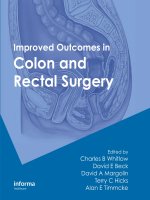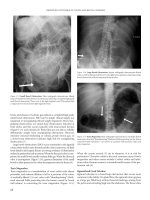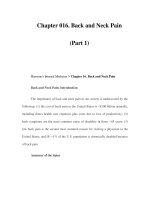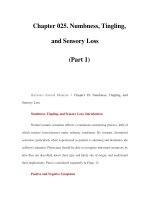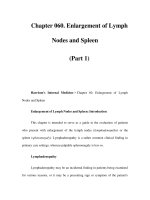Blood and Blood Transfusion - part 1 ppsx
Bạn đang xem bản rút gọn của tài liệu. Xem và tải ngay bản đầy đủ của tài liệu tại đây (81.14 KB, 8 trang )
Critical Care Focus
8: Blood and Blood Transfusion
EDITOR
DR HELEN F GALLEY
Senior Lecturer in Anaesthesia and Intensive Care
University of Aberdeen
EDITORIAL BOARD
PROFESSOR NIGEL R WEBSTER
Professor of Anaesthesia and Intensive Care
University of Aberdeen
DR PAUL G P LAWLER
Clinical Director of Intensive Care
South Cleveland Hospital
DR NEIL SONI
Consultant in Anaesthesia and Intensive Care
Chelsea and Westminster Hospital
DR MERVYN SINGER
Reader in Intensive Care
University College Hospital, London
© BMJ Books 2002
BMJ Books is an imprint of the BMJ Publishing Group
All rights reserved. No part of this publication may be reproduced, stored in a
retrieval system, or transmitted, in any form or by any means, electronic,
mechanical, photocopying, recording and/or otherwise, without the prior written
permission of the publishers.
First published in 2002
by BMJ Books, BMA House, Tavistock Square,
London WC1H 9JR
www.bmjbooks.com
www.ics.ac.uk
British Library Cataloguing in Publication Data
A catalogue record for this book is available from the British Library
ISBN 0-7279-1657-2
Typeset by Newgen Imaging Systems (P) Ltd, Chennai.
Printed and bound in Spain by GraphyCems, Nawarra
Contents
Contributors v
Preface vi
Introduction vii
1 Transfusion requirements in critical care 1
MARTIN G TWEEDDALE (On behalf of the Canadian
Critical Care Trials Group and the Transfusion
Requirements in Critical Care Investigations)
2 Bioactive substances in blood for transfusion 13
HANS J NIELS N
3 Haemostatic problems in the intensive care unit 23
SAMUEL J MACHIN
4 Activated protein C and severe sepsis 38
PIERRE
-FRANCOIS LATERRE
5 Transfusion-related acute lung injury 49
ANDREW BODENHAM
, SHEILA M
A
C
LENNAN, SIMON V BAUDOUIN
6 The use of colloids in the critically ill 57
CLAUDIO MARTIN
7 Radical reactions of haem proteins 66
CHRIS E COOPER
Index 81
E
Critical Care Focus series
Also available:
H F Galley (ed) Critical Care Focus 1: Renal Failure, 1999.
H F Galley (ed) Critical Care Focus 2: Respiratory Failure, 1999.
H F Galley (ed) Critical Care Focus 3: Neurological Injury, 2000.
H F Galley (ed) Critical Care Focus 4: Endocrine Disturbance, 2000.
H F Galley (ed) Critical Care Focus 5: Antibiotic Resistance and Infection
Control, 2001.
H F Galley (ed) Critical Care Focus 6: Cardiology in Critical Illness, 2001.
H F Galley (ed) Critical Care Focus 7: Nutritional Issues, 2001.
viii
CRITICAL CARE FOCUS: BLOOD AND BLOOD TRANSFUSION
Haemostatic problems in the intensive care unit
Samuel J Machin
Haemostatic failure is common in the intensive care unit. Haematological
advice can, at times, be confusing, and therefore the remit of this article
is to highlight specific areas of haemostatic failure, including both bleeding
and thrombosis, that are relevant to patients on the intensive care
unit. In addition, recent advances in terms of therapeutic strategies are
discussed.
Activated protein C and severe sepsis
Pierre-Francois Laterre
The inflammatory and pro-coagulant host responses to infection are
intricately linked. Decreased protein C levels observed in patients with
sepsis are associated with increased mortality. This article briefly describes
the interaction between inflammation and coagulation and the role
of protein C in the regulation of this interaction. The results of a large
multi-centre trial of activated protein C in patients with sepsis is also
presented and discussed. Since reductions in the relative risk of death
were observed regardless of whether patients had protein C deficiency
at baseline, it is suggested that activated protein C has pharmacological
effects beyond merely replacement of depleted endogenous levels. This
observation suggests that measurements of protein C are not necessary to
identify which patients would benefit from treatment with the drug.
Transfusion-related acute lung injury
Andrew Bodenham, Sheila MacLennan, Simon V Baudouin
Transfusion-related lung injury has been reported to occur in about 0·2%
of all transfused patients, although it is thought that this may be an
underestimate. The lung injury may be severe enough to warrant admission
to the intensive care unit for ventilation, and is similar to acute respiratory
distress syndrome in many respects. The exact cause of lung injury after
transfusion remains confusing, although it is suggested to be due
to the presence of donor antibodies. This article describes the
clinical manifestations, possible causes and similarity to other lung conditions
of transfusion-related lung injury and suggests future research strategies.
ix
INTRODUCTION
The use of colloids in the critically ill
Claudio Martin
Colloids are widely used in the replacement of fluid volume, although
doubts remain as to their benefits. Different colloids vary in their molecular
weight and therefore in the length of time they remain in the circulatory
system. Because of this and their other characteristics, they may differ
in their safety and efficacy. Plasma, albumin, synthetic colloids and
crystalloids may all be used for volume expansion but the first two are
expensive and crystalloids have to be given in much larger volumes than
colloids to achieve the same effect. Synthetic colloids provide a cheaper,
safe, effective alternative. There are three classes of synthetic colloid;
dextrans, gelatins and hydroxyethyl starches; each is available in several
formulations with different properties which affect their initial plasma
expanding effects, retention in the circulation and side-effects. This article
describes the physiology of fluids and colloids, presents key animal studies
that have contributed to the colloid-crystalloid debate, and describes the
present clinical position.
Radical reactions of haem proteins
Chris E Cooper
This article provides an overview of basic free radical chemistry and
biology before focusing on the reactions of haemoglobin and myoglobin as
sources of free radical damage. Free radicals are implicated in many
pathological conditions and free haem proteins in the circulation can
participate in radical reactions which result in toxicity.These reactions have
been shown to be relevant particularly in rhabdomyolysis and the side
effects of haemoglobin-based blood substitutes. Clinical experience with
chemically modified and genetically engineered haemoglobin blood
substitutes have uncovered side effects that must be addressed before a
viable oxygen-carrying alternative to blood can be developed. Research is
now being directed towards understanding the mechanisms of these toxic
side effects and developing methods of overcoming them.

